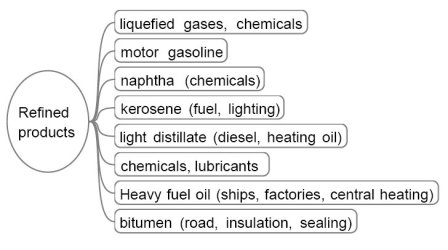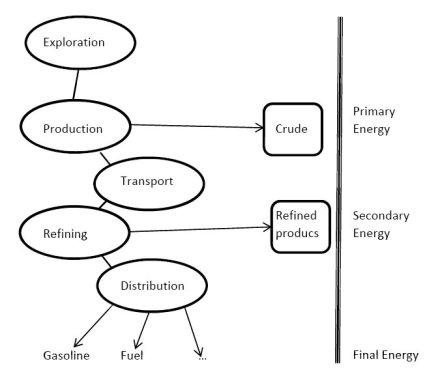Oil
Introduction
Liquid oil is easily transportable and can be distributed in variable amounts. Transportation networks and distribution of petroleum products, after departure from a refinery, are the least expensive and most flexible ones. In particular, oil nowadays is the form of energy most suitable for road, air and sea transport, all three being virtually captive markets for liquid fuels.

Another advantage offered by oil is the multiplicity of its uses. They have grown steadily over the last hundred years and now cover a huge range of products, as shown in Figureabove. The versatility of oil thus makes it a particularly attractive source of energy, and explains the strong growth of its market in the twentieth century.
Origin of oil
Oil and natural gas, mixtures of carbon and hydrogen, or hydrocarbons, originate from microorganism plants and animals accumulated at the bottom of the sea, which, due to geological upheavals, have been transformed into sludge gradually filtered by porous sedimentary rocks, and moved so that, blocked by impermeable soil layers, they form deposits.
The deposits consist of very variable dimensions extending to depths ranging from surface outcrops to almost 5,000 m. Their geological composition corresponds to porous rocks in which hydrocarbons are trapped, their porosity (and hence the concentration of oil) being at best equal to 25%. These rocks are called reservoir rocks or rocks stores, as opposed to bedrock where hydrocarbons were formed originally.
Oil sector
As shown in Figure below, the oil industry has five main branches :

To extract oil deposits, one must drill wells whose unit cost is very high, especially when it comes to underwater deposits (offshore). To limit the number of drillings, exploration has developed data mining methods from geology and geophysical knowledge.
Geological studies, based on the surface observation, possibly assisted by aerial photographs, help to identify the structure of the field and to locate areas with petroleum potential.
Geophysical prospecting is used to characterize the properties of a field, through gravity measurements (local variations of the gravity field), magnetometry (magnetic field variations), electrical resistance, and above all through seismic studies –consisting in following the path of artificially created underground shock waves (explosives or vibroseis). The computer analysis of the records now allows for fine interpretations.
When prospective studies suggest that a field exists, exploration drilling is undertaken at depths ranging generally between 800 and 5,000 m, but which may even exceed 10,000 m.
Most modern oil explorations, even based on state-of-the-art geological and geophysical techniques, remain highly uncertain and entail a high financial risk reserved for large companies.
In total, worldwide, between 30,000 and 35,000 petroleum basins have been discovered. Most are small, while only 1% of them contain 90% of world reserves. There are now about 600 high capacity tanks, among which 200 have never been explored and 240 have more or less been explored, but are not productive.
Production
A deposit is exploited by drilling several wells. According to the natural pressure in the reservoir, production can occur spontaneously or requires the use of pumps (surface suction / pendulum pressure pumps, or, increasingly, electric pumps in the well).
These means correspond to the primary recovery, which generally does not collect more than 20% of the potential of the deposit.
To improve the efficiency, it is necessary to systematically inject water or gas under pressure in one or more locations, thereby facilitating the surge of the oil to production wells. This is called the secondary recovery. On average, it can improve the recovery rate to 33%.
Finally, the tertiary recovery phase, much more expensive and under ongoing technological development, is expected to increase the rate of extraction to 40 or 50% by injecting steam, miscible hydrocarbons or diluted chemicals in water before decanting the extracted oil to separate the gas and salt water.
These techniques are expensive and therefore only justified if prices exceed certain thresholds.
The complete exploitation of an oil field takes several years and can take up to 15 years for a large offshore field. In the latter case, it is necessary to use platforms that are set down or anchored to the seabed depending on depth.
The development of offshore exploration and production was made necessary by the rapid depletion of the ground reserves. The oceans representing 70% of the Earth's surface, the potential oil they contain is indeed considerable, even if the environment is much more hostile.
Initially developed near the coast where large deposits were, offshore exploration and production then extended to access much more difficult areas such as the North Sea, off the coast of Labrador, etc. Approximately 30% of the oil produced in the world today comes from the seabed, and this proportion is expected to remain stable in the near future.
Transport to refineries
From production wells to refineries, crude oil transportation is provided either by tankers or by pipelines.
The advantage of delivering it by sea is that the destination of the cargo can change at any time, although tankers must return empty to places of loading.
Refining
The main technical constraint is that crude oil can hardly be used as it is, and it is therefore necessary to refine it to produce "derivatives" or "products", which correspond to very different uses, either related to energy or chemistry.
Refining is separating the various hydrocarbon oil components. This is done using physical and physico-chemical processes that yield four major product categories or "cuts": liquefied petroleum gas (LPG), gasoline, middle distillates (light fuel oil and diesel), and heavy fuel oil, as shown in Figure below.

The atmospheric distillation unit allows for separating primary products at atmospheric pressure, depending on their volatility. Oil is introduced at 380 °C, and the vapors are then separated by condensation at temperatures ranging from 120 °C to 255 °C. At the bottom remains a heavy residue, called atmospheric residue.
To recover it, it is distilled under vacuum at 480 °C, which provides a distillate that catalytic cracking can separate into lighter products. More gasoline fuel is thus obtained.
Reforming is used to transform the heavy gasoline fuel to high octane fuel. It is obtained by passing the gas over a platinum catalyst at 500 °C.
Note that refining is a highly constrained problem, the products depending to a large extent on the composition of the incoming crude. Refineries are not able to easily adjust their production to a strong evolution of demand, and a large part of the difficulty in this area stems from that rigidity.
Indeed, the growing concern over the use of oil reserves for specific uses (road and air), has induced a significant reduction of the global demand for heavy products since the first oil shocks. To cope with this development, and to enhance the value of oil, deep conversion technologies are being developed in the most efficient refineries.
These very expensive technologies can "crack" heavy molecules to obtain lighter ones. It is thus possible to reduce the production of heavy cuts threefold compared to a refinery without a conversion unit, and by a factor of two compared to a refinery equipped with a conventional conversion unit.
Distribution
While production and refining activities remain centralized, distribution of petroleum products may be more widely scattered.
The method of distribution depends on the demands of the consumer:
large consumers generally receive their product directly from the refineries;
final delivery to small consumers is only by road.
Oil companies must have deposits, used as strategic storage (90 days' consumption for the Member States of the European Union, and imports for those of IEA) and to respond to economic fluctuations in demand. They are usually located close to consumption areas.
